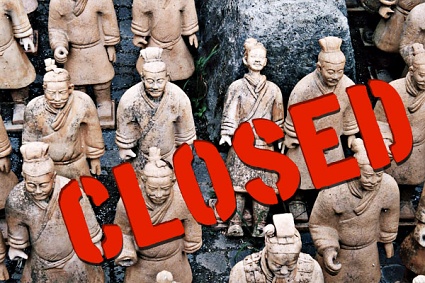Looks like Texas has lost yet another of its great roadside attractions. Before, it was Austin's Cathedral of Junk. This time, it's Forbidden Gardens, the Chinese tiny town that's quietly stood outside Houston for the past 15 years.
It was the pet project of reclusive millionaire Ira Poon, who spent a reported $20 million recreating the extensive imperial palace in Beijing known as the Forbidden City in one-tenth scale, as well as a one-third-scale recreation of the awe-inspiring 6,000-piece, terra-cotta army of Emperor Qin.
Throughout its life, the park has seen little attendance due to Poon's unexplained aversion to advertising. Couple that with the staff's struggle to keep the park in shape due to the region's harsh heat and humidity, and the attraction has long seemed destined for an early closure.
Unfortunately, I didn't find out about Forbidden Gardens' demise till the last minute, and even then I was out of the state. So, with great regret, I was unable to attend the park's swan song, a mass sell-off that occurred over the weekend.
On Saturday and Sunday, more than 2,300 patrons lined up to buy pieces of the failed park, from $1 figurines to $250 life-size soldiers. Each of the 6,000 terra-cotta warriors, which I myself have coveted since I visited the park 10 years ago, went for $100 apiece.
The official reason for Forbidden Gardens' closure is due to the expansion of a nearby highway. There are, however, many who believe that's just an excuse, as the attraction has been on the decline for some time.
Poon had reportedly always been more interested in making a contribution to local culture than in making a profit, but his dedication to the attraction seemed to wane as the years went by. Near the end, efforts by the park's small staff to maintain the handcrafted models had become more desperate, going so far as to involve spare parts purchased at a local hobby store.
For a time, some held out hope for a wholesale buyout by someone interested in relocating the park, but an offer never came. In the end, the only choice was to disseminate the collection to the public.
For more information on the park as it once was, read my story from 2002, which was republished in Weird Texas. For pictures of the park's last days, you can read an article that appeared in today's The Wall Street Journal, in which I was quoted as one of those mourning the loss.
Oh, and if someone out there finds himself with one too many terra-cotta soldiers, I'd be willing to make an offer.




